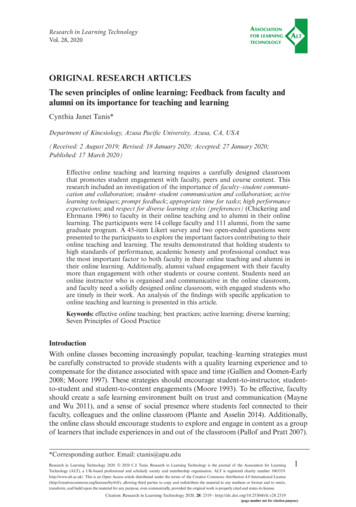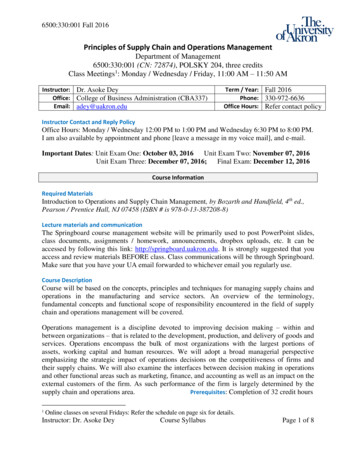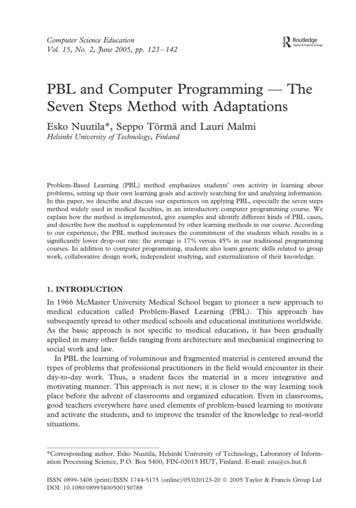
Transcription
The Seven Principles of Supply Chain ManagementThe Seven Principles of Supply Chain ManagementDAVID L. ANDERSON, FRANK F. BRITT, and DONAVON J. FAVRE -- 4/1/1997To balance customers' demands with the need for profitable growth,many companies have moved aggressively to improve supply chainmanagement. Their efforts reflect seven principles of supply chainmanagement that, working together, can enhance revenue, cost control,and asset utilization as well as customer satisfaction. Implementedsuccessfully, these principles prove convincingly that you can pleasecustomers and enjoy profitable growth from doing so.Managers increasingly find themselvesassigned the role of the rope in a very realtug of war—pulled one way by customers'mounting demands and the opposite way bythe company's need for growth andprofitability. Many have discovered that theycan keep the rope from snapping and, infact, achieve profitable growth by treatingsupply chain management as a strategicvariable.Seven Principles1. Segment customers based onservice needs.2. Customize the logisticsnetwork.3. Listen to signals of marketdemand and plan accordingly.4. Differentiate product closer tothe customer.5. Source strategically.6. Develop a supply chain-widetechnolgy strategy.7. Adopt channel-spanningperformance measures.These savvy managers recognize twoimportant things. First, they think about thesupply chain as a whole—all the linksinvolved in managing the flow of products,services, and information from theirsuppliers' suppliers to their customers'customers (that is, channel customers, suchas distributors and retailers). Second, they pursue tangible outcomes—focusedon revenue growth, asset utilization, and cost reduction.Rejecting the traditional view of a company and its component parts as distinctfunctional entities, these managers realize that the real measure of success ishow well activities coordinate across the supply chain to create value forcustomers, while increasing the profitability of every link in the chain. In theprocess, some even redefine the competitive game; consider the success ofProcter & Gamble (see "The Power of Partnership").Our analysis of initiatives to improve supply chain management by more than100 manufacturers, distributors, and retailers shows many making greatprogress, while others fail dismally. The successful initiatives that havecontributed to profitable growth share several themes. They are typically broadefforts, combining both strategic and tactical change. They also reflect a holisticapproach, viewing the supply chain from end to end and orchestrating efforts sothat the whole improvement achieved—in revenue, costs, and asset utilization—is greater than the sum of its parts.Unsuccessful efforts likewise have a consistent profile. They tend to befunctionally defined and narrowly focused, and they lack sustaininginfrastructure. Uncoordinated change activity erupts in every department andfunction and puts the company in grave danger of "dying the death of athousand initiatives." The source of failure is seldom management's sp?layout articlePrint&articleID CA185647 (1 of 15)12/21/2005 5:44:01 PM
The Seven Principles of Supply Chain Managementidentifying what needs fixing. The issue is determining how to develop andexecute a supply chain transformation plan that can move multiple, complexoperating entities (both internal and external) in the same direction.To help managers decide how to proceed, we revisited the supply chaininitiatives undertaken by the most successful manufacturers and distilled fromtheir experience seven fundamental principles of supply chain management.Adherence to the seven principles transforms the tug of war between customerservice and profitable growth into a balancing act. By determining whatcustomers want and how to coordinate efforts across the supply chain to meetthose requirements faster, cheaper, and better, companies enhance bothcustomersatisfaction and their own financial performance. But the balance is noteasy to strike or to sustain. As this article will demonstrate, each company—whether a supplier, manufacturer, distributor, or retailer—must find the way tocombine all seven principles into a supply chain strategy that best fits itsparticular situation. No two companies will reach the same conclusion.Principle 1: Segment customers based on the service needs of distinctgroups and adapt the supply chain to serve these segments profitably.Segmentation has traditionally grouped customers by industry, product, or tradechannel and then taken a one-size-fits-all approach to serving them, averagingcosts and profitability within and across segments. The typical result, as onemanager admits: "We don't fully understand the relative value customers placeon our service offerings."But segmenting customers by their particular needs equips a company todevelop a portfolio of services tailored to various segments. Surveys, interviews,and industry research have been the traditional tools for defining keysegmentation criteria.Today, progressive manufacturers are turning to such advanced analyticaltechniques as cluster and conjoint analysis to measure customer tradeoffs andpredict the marginal profitability of each segment. One manufacturer of homeimprovement and building products bases segmentation on sales andmerchandising needs and order fulfillment requirements. Others are finding thatcriteria such as technical support and account planning activities drivesegmentation.Viewed from the classicperspective, this needs-basedsegmentation may producesome odd couples. For themanufacturer in Exhibit 1,"innovators" include anindustrial distributor(Grainger), a do-it-yourselfretailer (Home Depot), and amass merchant asp?layout articlePrint&articleID CA185647 (2 of 15)12/21/2005 5:44:01 PM
The Seven Principles of Supply Chain ManagementResearch also can established the services valued by all customers versus thosevalued only by certain segments.Then the company should apply a disciplined, cross-functional process to developa menu of supply chain programs and create segment-specific service packagesthat combine basic services for everyone with the services from the menu thatwill have the greatest appeal to particular segments. This does not meantailoring for the sake of tailoring. The goal is to find the degree of segmentationand variation needed to maximize profitability.All the segments in Exhibit 1, for example, value consistent delivery. Butthose in the lower left quadrant have little interest in the advanced supply chainmanagement programs, such as customized packaging and advance shipmentnotification, that appeal greatly to those in the upper right quadrant.Of course, customer needs and preferences do not tell the whole story. Theservice packages must turn a profit, and many companies lack adequatefinancial understanding of their customers' and their own costs to gauge likelyprofitability. "We don't know which customers are most profitable to serve,which will generate the highest long-term profitability, or which we are mostlikely to retain," confessed a leading industrial manufacturer. This knowledge isessential to correctly matching accounts with service packages—hich translatesinto revenues enhanced through some combination of increases in volume and/or price.Only by understanding their costs at the activity level and using thatunderstanding to strengthen fiscal control can companies profitably deliver valueto customers. One "successful" food manufacturer aggressively marketed vendormanaged inventory to all customer segments and boosted sales. But subsequentactivity-based cost analysis found that one segment actually lost nine cents acase on an operating margin basis.Most companies have a significant untapped opportunity to better align theirinvestment in a particular customer relationship with the return that customergenerates. To do so, companies must analyze the profitability of segments, plusthe costs and benefits of alternate service packages, to ensure a reasonablereturn on their investment and the most profitable allocation of resources. Tostrike and sustain the appropriate balance between service and profitability,most companies will need to set priorities—sequencing the rollout of tailoredprograms to capitalize on existing capabilities and maximize customer impact.Principle 2: Customize the logistics network to the service requirementsand profitability of customer segments.Companies have traditionally taken a monolithic approach to logistics layout articlePrint&articleID CA185647 (3 of 15)12/21/2005 5:44:01 PM
The Seven Principles of Supply Chain Managementdesign in organizing their inventory, warehouse, and transportation activities tomeet a single standard. For some, the logistics network has been designed tomeet the average service requirements of all customers; for others, to satisfythe toughest requirements of a single customer segment.Neither approach can achieve superior asset utilization or accommodate thesegment-specific logistics necessary for excellent supply chain management. Inmany industries, especially such commodity industries as fine paper, tailoringdistribution assets to meet individual logistics requirements is a greater source ofdifferentiation for a manufacturer than the actual products, which are largelyundifferentiated.One paper company found radically different customer service demands in twokey segments—large publishers with long lead times and small regional printersneeding delivery within 24 hours. To serve both segments well and achieveprofitable growth, the manufacturer designed a multi-level logistics network withthree full-stocking distribution centers and 46 quick-response cross-docks,stocking only fast-moving items, located near the regional printers.Return on assets and revenues improved substantially thanks to the newinventory deployment strategy, supported by outsourcing of management of thequick response centers and the transportation activities.This example highlightsseveral keycharacteristics ofsegment-specific services.The logistics networkprobably will be morecomplex, involvingalliances with third-partylogistics providers, andwill certainly have to bemore flexible than thetraditional network. As aresult, fundamentalchanges in the mission,number, location, andownership structure of warehouses are typically necessary. Finally, the networkwill require more robust logistics planning enabled by "real-time" decisionsupport tools that can handle flow-through distribution and more time-sensitiveapproaches to managing transportation.Even less conventional thinking about logistics is emerging in some industries,where shared customers and similar geographic approaches result in redundantnetworks. Combining logistics for both complementary and competing firmsunder third-party ownership can provide a lower-cost industrywide solution.As shown in Exhibit 2, the food and packaged goods industry might well cutlogistics costs 42 percent per case and reduce total days in the system 73percent by integrating logistics assets across the industry, with extensiveparticipation by third-party logistics sp?layout articlePrint&articleID CA185647 (4 of 15)12/21/2005 5:44:01 PM
The Seven Principles of Supply Chain ManagementPrinciple 3: Listen to market signals and align demand planningaccordingly across the supply chain, ensuring consistent forecasts andoptimal resource allocation.Forecasting has historically proceeded silo by silo, with multiple departmentsindependently creating forecasts for the same products—all using their ownassumptions, measures, and level of detail. Many consult the marketplace onlyinformally, and few involve their major suppliers in the process. The functionalorientation of many companies has just made things worse, allowing salesforecasts to envision growing demand while manufacturing second-guesses howmuch product the market actually wants.Such independent, self-centered forecasting is incompatible with excellent supplychain management, as one manufacturer of photographic imaging found. Thismanufacturer nicknamed the warehouse "the accordion" because it had to copewith a production operation that stuck to a stable schedule, while the revenuefocused sales force routinely triggered cyclical demand by offering deepdiscounts at the end of each quarter. The manufacturer realized the need toimplement a cross-functional planning process, supported by demand planningsoftware.Initial results were dismaying. Sales volume dropped sharply, as excessinventory had to be consumed by the marketplace. But today, the companyenjoys lower inventory and warehousing costs and much greater ability tomaintain price levels and limit discounting. Like all the best sales and operationsplanning (S&OP), this process recognizes the needs and objectives of eachfunctional group but bases final operational decisions on overall profit potential.Excellent supply chain management, in fact, calls for S&OP that transcendscompany boundaries to involve every link of the supply chain (from thesupplier's supplier to the customer's customer) in developing forecastscollaboratively and then maintaining the required capacity across the operations.Channel-wide S&OP can detect early warning signals of demand lurking incustomer promotions, ordering patterns, and restocking algorithms and takesinto account vendor and carrier capabilities, capacity, and constraints.Exhibit 3 illustrates thedifference that cross supplychain planning has made forone manufacturer of laboratoryproducts. As shown on the left ofthis exhibit, uneven distributordemand unsynchronized withactual end-user demand made realinventory needs impossible topredict and forced high inventorylevels that still failed to preventout-of-stocks.Distributors b
The Seven Principles of Supply Chain Management The Seven Principles of Supply Chain Management DAVID L. ANDERSON, FRANK F. BRITT, and DONAVON J. FAVRE -- 4/1/1997 To balance customers' demands with the need for profitable growth, many companies have moved aggressively to improve supply chain management. Their efforts reflect seven principles of supply chain management











